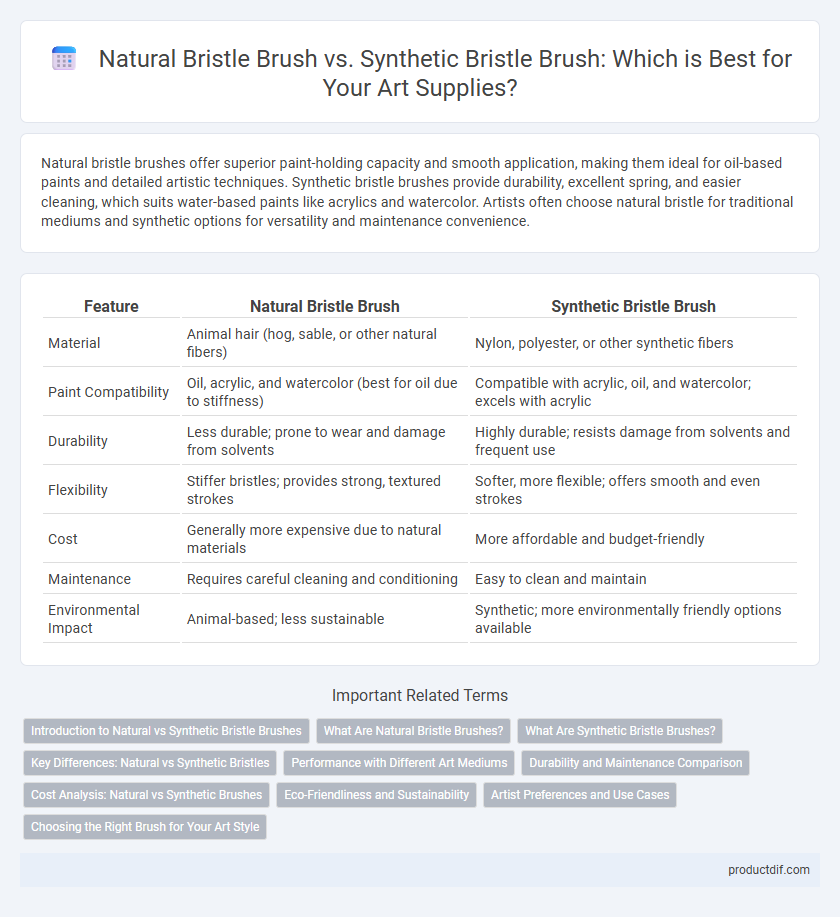Natural bristle brushes offer superior paint-holding capacity and smooth application, making them ideal for oil-based paints and detailed artistic techniques. Synthetic bristle brushes provide durability, excellent spring, and easier cleaning, which suits water-based paints like acrylics and watercolor. Artists often choose natural bristle for traditional mediums and synthetic options for versatility and maintenance convenience.
Table of Comparison
| Feature | Natural Bristle Brush | Synthetic Bristle Brush |
|---|---|---|
| Material | Animal hair (hog, sable, or other natural fibers) | Nylon, polyester, or other synthetic fibers |
| Paint Compatibility | Oil, acrylic, and watercolor (best for oil due to stiffness) | Compatible with acrylic, oil, and watercolor; excels with acrylic |
| Durability | Less durable; prone to wear and damage from solvents | Highly durable; resists damage from solvents and frequent use |
| Flexibility | Stiffer bristles; provides strong, textured strokes | Softer, more flexible; offers smooth and even strokes |
| Cost | Generally more expensive due to natural materials | More affordable and budget-friendly |
| Maintenance | Requires careful cleaning and conditioning | Easy to clean and maintain |
| Environmental Impact | Animal-based; less sustainable | Synthetic; more environmentally friendly options available |
Introduction to Natural vs Synthetic Bristle Brushes
Natural bristle brushes feature hairs sourced from animals such as hog or sable, offering excellent paint retention and a rough texture ideal for oil and acrylic painting. Synthetic bristle brushes are crafted from nylon or polyester fibers designed to mimic natural hair while providing greater flexibility, durability, and resistance to solvents. Choosing between natural and synthetic bristles depends on the medium used and the desired brush performance, with natural bristles excelling in heavier paints and synthetic brushes preferred for smooth application and ease of cleaning.
What Are Natural Bristle Brushes?
Natural bristle brushes are made from the hairs of animals such as hogs, boars, or badgers, offering superior paint-holding capacity and durability. These brushes excel in oil and acrylic painting due to their stiffness and ability to create textured strokes. Known for their ability to maintain shape and provide excellent control, natural bristle brushes are a top choice for professional artists seeking high-quality application tools.
What Are Synthetic Bristle Brushes?
Synthetic bristle brushes are art tools made from man-made fibers such as nylon, polyester, or Taklon, designed to mimic the texture and performance of natural bristles. These brushes offer increased durability, resistance to wear, and are ideal for acrylics, oils, and watercolors due to their ability to maintain shape and deliver consistent strokes. Artists often choose synthetic brushes for their affordability, ease of cleaning, and cruelty-free materials, making them a versatile option for various painting techniques.
Key Differences: Natural vs Synthetic Bristles
Natural bristle brushes feature fibers derived from animal hair, offering superior paint retention and a softer, more flexible stroke ideal for oil and acrylic painting. Synthetic bristle brushes, made from nylon or polyester, provide increased durability, resistance to wear, and better performance with water-based paints. The key differences lie in texture, paint absorption, and suitability for different mediums, making natural bristles preferable for smooth blends and synthetic bristles better for precise details and easier cleaning.
Performance with Different Art Mediums
Natural bristle brushes excel in oil painting and acrylics due to their stiffness and excellent paint-holding capacity, offering superior texture and control. Synthetic bristle brushes perform better with watercolors and delicate media, providing smooth application and greater flexibility while resisting water damage. Artists choose based on medium compatibility, with natural bristles favored for heavy-bodied paints and synthetics preferred for lighter, water-based pigments.
Durability and Maintenance Comparison
Natural bristle brushes, made from animal hair, tend to be less durable due to their susceptibility to damage from water and solvents, requiring careful cleaning and conditioning to maintain their shape and integrity. Synthetic bristle brushes, crafted from nylon or polyester, offer superior durability by resisting wear, moisture, and mildew, making them easier to clean and maintain with regular soap and water. Artists seeking longevity and low-maintenance tools often prefer synthetic bristles for their consistent performance and resilience under frequent use.
Cost Analysis: Natural vs Synthetic Brushes
Natural bristle brushes typically have a higher upfront cost due to the quality of animal hair, but their durability can lead to long-term savings for frequent artists. Synthetic bristle brushes are generally more affordable, offering cost-effective options for beginners or those who require multiple brushes for varied techniques. Evaluating the cost-effectiveness depends on the frequency of use, painting medium, and the need for precision in application.
Eco-Friendliness and Sustainability
Natural bristle brushes, made from animal hair, offer biodegradability and compostability, contributing to eco-friendliness but raising concerns about animal welfare and resource harvesting. Synthetic bristle brushes, typically crafted from nylon or polyester, provide durability and resistance to wear, often derived from non-renewable petroleum sources, posing greater environmental impact but can be engineered for recyclability. Choosing between them involves balancing biodegradability and natural resource use with synthetic material longevity and recyclability in sustainable art practices.
Artist Preferences and Use Cases
Natural bristle brushes, made from hog or sable hair, offer superior paint retention and smoother application, preferred by artists working with oil and acrylic paints for textured, dynamic strokes. Synthetic bristle brushes, crafted from nylon or polyester, provide greater durability, resistance to solvents, and affordability, making them ideal for watercolor, gouache, and beginners exploring diverse techniques. Artists often select natural bristles for detailed, traditional work and synthetic brushes for versatile, easy-maintenance projects requiring consistent performance.
Choosing the Right Brush for Your Art Style
Natural bristle brushes, made from animal hair, offer superior paint holding and texture, ideal for oil and acrylic artists seeking rich, expressive strokes. Synthetic bristle brushes, crafted from nylon or polyester, provide durability, resistance to wear, and versatility across mediums, suitable for watercolorists and beginners. Selecting the right brush depends on your preferred paint type, desired texture, and brush maintenance preferences to enhance your artistic technique.
Natural bristle brush vs Synthetic bristle brush Infographic

 productdif.com
productdif.com